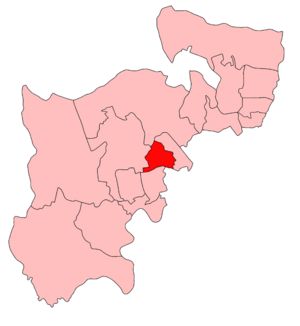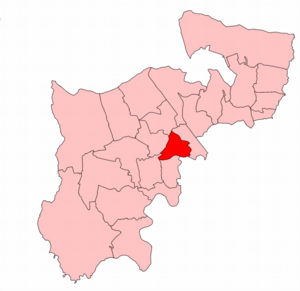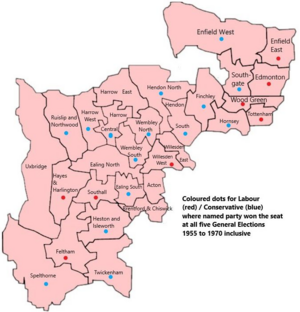Willesden West (UK Parliament constituency) facts for kids
Quick facts for kids {{{Name}}}[[{{{Type}}} constituency]] |
|
|---|---|
| [[Image:{{{Map1}}}Constituency.svg|120px|]] [[Image:England{{{Map2}}}.svg|120px|]] |
|
| {{{Name}}} shown within [[{{{Entity}}}]], and {{{Entity}}} shown within England | |
| Created: | {{{Year}}} |
| MP: | {{{MP}}} |
| Party: | {{{Party}}} |
| Type: | House of Commons |
| County: | [[{{{County}}}]] |
| EP constituency: | [[{{{EP}}} (European Parliament constituency)|{{{EP}}}]] |
Willesden West was a special area in Middlesex, near London, that had its own representative in the UK Parliament. From 1918 to 1974, people living in Willesden West voted for one person to be their MP. This MP would then go to the House of Commons to speak up for the people of Willesden West.
For most of its history, Willesden West elected an MP from the Labour Party. This trend started in 1923. There was one time, between 1931 and 1935, when a famous supporter of women's rights, Mrs Mavis Tate, was elected from the Conservative Party.
Contents
History of Willesden West
Before 1918, the area of Willesden was part of a larger constituency called Harrow Division. The Willesden West constituency was officially created by a law called the Representation of the People Act 1918. This law changed how people voted and created many new voting areas.
The first time people voted for an MP in Willesden West was in the general election of 1918. The borders of the constituency were changed again in 1948 by another law.
Willesden West stopped being a constituency in February 1974. This happened because new areas called London Boroughs were created in London in 1965. The area of Willesden West was then split into two new constituencies: Brent East and Brent North.
Understanding the Boundaries
When a constituency is created, it has specific borders, or "boundaries," that show which areas belong to it. The 1918 law created a new parliamentary area called Willesden, which was the same size as the urban district of Willesden. This area was then divided into two parts: Willesden West and Willesden East.
Willesden West included five smaller areas called "wards." These wards were Church End, Harlesden, Roundwood, Stonebridge, and Willesden Green. The other six wards formed the Willesden East constituency. In 1933, Willesden became a "municipal borough," which is a type of town council, but this did not change the parliamentary boundaries.
Before the 1950 general election, the boundaries of Willesden West were changed again. It then included seven wards: Church End, Harlesden, Kensal Rise, Manor, Roundwood, Stonebridge, and Willesden Green. The Kensal Rise ward had previously been part of Willesden East.
Members of Parliament for Willesden West
A Member of Parliament (MP) is a person elected by the people in a constituency to represent them in the House of Commons. Here are the MPs who represented Willesden West:
| Election | Member | Party | |
|---|---|---|---|
| 1918 | Charles Pinkham | Conservative | |
| 1922 | George James Furness | Conservative | |
| 1923 | Samuel Viant | Labour | |
| 1931 | Mavis Tate | Conservative | |
| 1935 | Samuel Viant | Labour | |
| 1959 | Laurie Pavitt | Labour | |
| Feb 1974 | constituency abolished | ||
How Elections Worked
Elections are how people choose their representatives. In the UK, general elections usually happen every few years. People vote for the candidate they want to represent their area in Parliament. The candidate who gets the most votes wins and becomes the MP.
Here's a quick look at some of the election results for Willesden West:
- In 1918, the first election, Charles Pinkham from the Conservative Party won.
- In 1923, Samuel Viant from the Labour Party won the seat. He held it for many years.
- In 1931, during a tough time for the Labour Party, Mavis Tate from the Conservative Party won. She was a notable woman's rights advocate.
- However, in 1935, Samuel Viant won the seat back for the Labour Party.
- From 1959 until the constituency was abolished in 1974, Laurie Pavitt from the Labour Co-operative Party was the MP.
The detailed results of each election show how many votes each candidate received and how the support for different parties changed over time in Willesden West.




